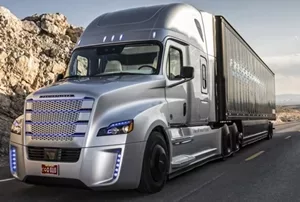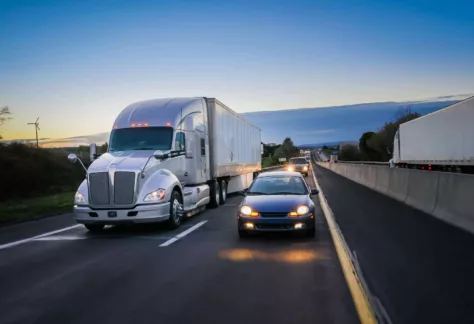The future of driverless trucks is inching closer to reality. This is largely due, in part, to the aggressive push being made for autonomous cars. According to Wolfgang Bernard with Diamler, by the time federal laws are implemented and regulation is finished, his company will be ready with the first autonomous tractor-trailer. Bernhard made the announcement recently during a press conference after Daimler’s launched production of its Detroit-branded DT12 automated manual transmission in the United States.

Pictured self-driving 18-wheel truck (Courtesy: Domain-b)
Future Truck 2025
Last year, Diamler unveiled its Future Truck 2015 in Magdeburg, Germany. Ultimately, the company hopes to make safer, greener, and more efficient robotic trucks that are also more attractive to prospective drivers.
Based on Mercedes Benz’s previous work on driver assist and autonomous systems for upmarket passenger cars, it allows trucks to operate with complete autonomy on public roads at speeds up to 53 mph.
The Potentials Benefits of ‘Driverless Trucks’
- Could eliminate the shortage of drivers
- Better fuel economy
- New safety systems in place designed to offset common driver issues, such as drowsy driving, that impact road safety.
- Could allow truckers to take on new roles while still in the cab of a truck
- Could reduce the number of fatal bus and truck crashes
Critics Skeptical of ‘Driverless Trucks’
Though widespread deployment of autonomous trucks is still a ways off, the seeds have already been planted. To learn more, Software Advice, a company that researches and reviews fleet management software, conducted a survey of 385 adults in the United States to see what people think about this technology. Most people surveyed do not trust these type of vehicles on the ride. Other findings include:
Over two-thirds of survey respondents said they would feel less safe sharing the road with driverless semi-trucks.
- Women were more likely than men to think that vehicles piloted by driverless technology would be less safe than vehicles operated by human beings.
- The majority of respondents would be uncomfortable with driverless semi-trucks, even if it meant cheaper consumer products or reduced carbon emissions.
Obstacles Ahead
No shortage of hurdles remains for autonomous truck to hit the highways in numbers. Diamler reps have stated that:
- Local laws must first take effect, allowing drivers to let go of the steering wheel.
- The FMCSA will have to implement/write new rules drivers must follow when operating autonomous trucks
Referrals & Co-Counsel
Involved in a Crash?
No other law firm knows trucks quite like us. Our trucking law expertise and trial experience allow us to win multi-million-dollar results year after year.
Our team of truck accident attorneys works tirelessly to help your family find justice in the wake of a catastrophic truck crash.
Referrals & Co-Counsel
No other law firm knows trucks quite like us. Our trucking law expertise and trial experience allow us to win multi-million-dollar results year after year.
Involved in a Crash?
Our team of truck accident attorneys works tirelessly to help your family find justice in the wake of a catastrophic truck crash.
Our Thoughts
While welcome opportunities in technology that promote and increase highway safety, the verdict is still out on autonomous tractor trailers. Before these futuristic semis ever hit the road, they must be 100 percent reliable. Drivers in passenger vehicles must feel confident and unafraid when sharing the road with them.
In theory, driverless vehicles would put personal injury attorneys out of business. After all, manufacturers tout they will drastically reduce collisions. Fewer collisions mean few civil lawsuits. But, nonetheless, accidents will likely be inevitable—despite the advanced technology.
With that said, what happens when a driverless 18-wheeler kills someone? Robots cannot exactly be charged with a crime. Or less drastically, who pays the ticket when it doesn’t notice a stop sign or traffic light, or when an error sends it the wrong way down a one-way street?
Bottom line, there are still so many unknowns. As robots become more integrated into our every day life and society as a whole, lawmakers will have to wrestle with how to manage machines and hold software accountable.


